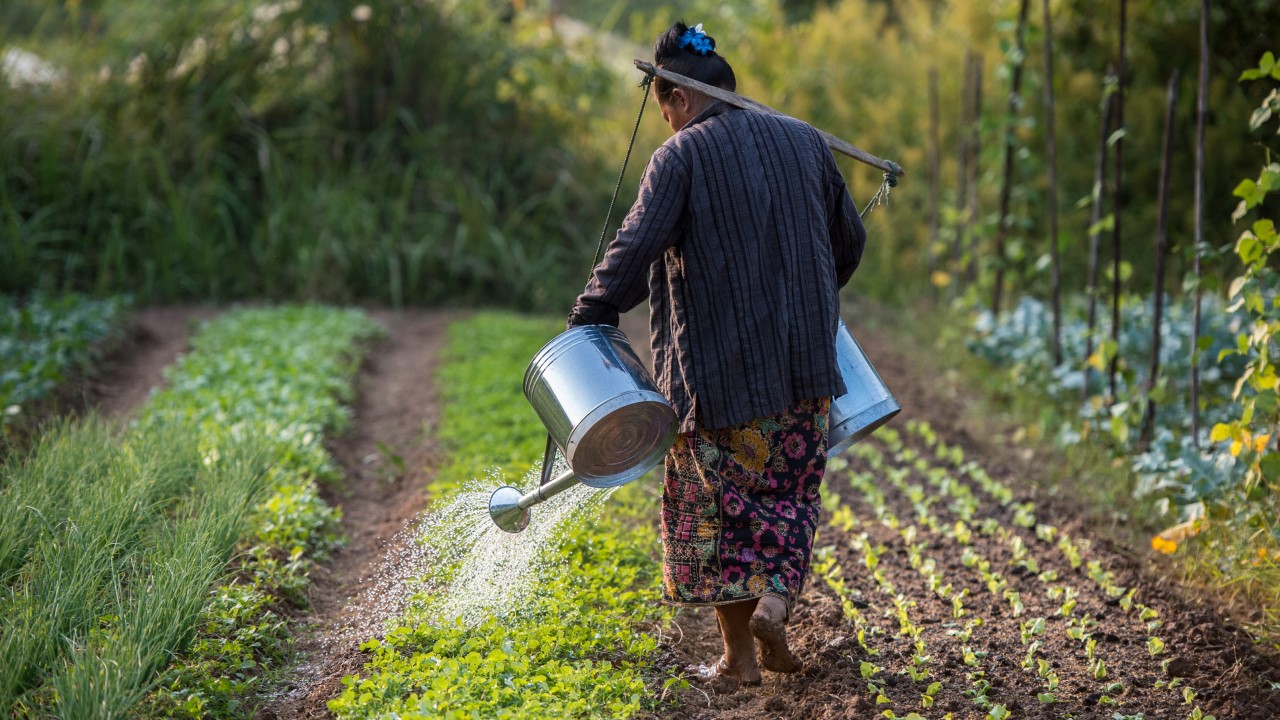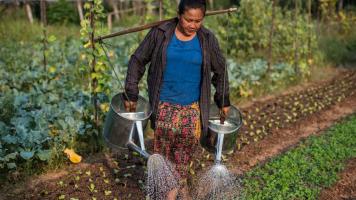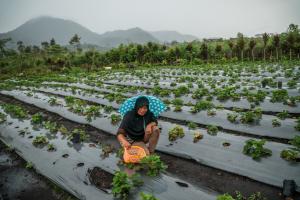
Agriculture is a victim and perpetrator of climate change. Photo credit: ADB.
Pursuing policy actions—from plate to planet—can help boost food and nutrition security while strengthening the sustainability of agrifood systems in the region.
Food lies at the intersection of many aspects of the global development agenda. It impacts the interlinked issues of economic growth, health, biodiversity, resource use, and climate, thereby requiring multidisciplinary approaches and integrated solutions.
As it stands, the way food is produced and consumed is contributing to a substantial environmental and carbon footprint. According to the United Nations, the cost of food waste amounts to over $2.6 trillion per year. Yet, many people around the world, including those in the region, are undernourished despite the unsustainable food production and consumption patterns.
As the COVID-19 pandemic unfolded, food insecurity increased. Food consumption and nutrition were significantly affected by loss of livelihoods and limited food access. The war in Ukraine caused food prices to hit record highs, deepening the woes of the poorest and most vulnerable. The price of some commodities is beginning to moderate, but many challenges remain, including the volatility in fertilizer prices that poses a threat to the production of rice—a key staple in Southeast Asia.
The webinar Strengthening the Agrifood System—organized by the Asian Development Bank (ADB)—examined the factors that threaten food security in Southeast Asia and how various stakeholders can support the agriculture food system in the region.
What’s eating the agrifood sector
Agriculture provides significant economic contribution to many Southeast Asian countries. According to an ADB study, more than 20% of Myanmar and Cambodia gross domestic product in 2019 came from this sector. However, the region’s agrifood system suffers from low productivity, competitiveness, and incomes, leading to high rural poverty. Constraints point to the lack of a conducive environment for private investment and weak linkages among agrifood stakeholders.
Meanwhile, the increasing intensity and frequency of extreme weather events are affecting crop yields and production. While agriculture is a victim of climate change, it is also a perpetrator of this phenomenon. It is highly impacted by the effects of a changing climate and at the same time, farming practices from intensive agriculture are contributing to rising emissions and environmental degradation. Although global warming affects all sectors, agriculture is the most vulnerable because it is dependent on climactic conditions such as rainfall, temperature, and soil ecosystem.
As incomes and urbanization increase, dietary preferences are moving toward resource-intensive food products. Tastes are also becoming more similar, resulting in the standardization of diet and homogenization of food supplies. “We can see that the global standard consumer or eater now obtains the majority of calories from six commodities only: wheat, rice, sugar, maize, soybean, and animal products,” said Omer Zafar, principal natural resources and agriculture specialist at ADB's Southeast Asia Department. “So, the loss of diversity in crops, livestock, and fishery species is a serious threat to food security and the widespread consumption of processed packaged food is a serious threat to nutrition.”
Compounding this issue is the dominance of only a handful of companies in the food supply chain. This market concentration is a serious concern because the size and influence of these multinational corporations enables them to largely control what farmers grow, how much they are paid, and what consumers eat.
On top of these challenges, the Russian invasion of Ukraine has led to a reduction in supply of commodities, triggering high food inflation. With many households still recovering from the hardships of the pandemic, the global price shocks are affecting their ability to purchase nutritious food. “Households, families, and individuals need to make decisions about which food they can afford to purchase to meet their energy needs,” said World Food Programme Indonesia Deputy Country Director Jennifer Rosenzweig. “And often, the foods that are more affordable are basic staples, which don’t always provide a diverse diet and allow families or individuals—especially those who are most in need of good nutrition such as young children and pregnant and lactating women—to be able to afford the foods that they need for a nutritious diet.”
Prior to the geopolitical crisis, the food situation in the region was already worrisome. According to the Food and Agriculture Organization, 418 million Asians were undernourished in 2020. The number of children in Asia under age 5 who still suffer stunting remained significant at 74.7 million, with 15.3 million from Southeast Asia.
Finally, infrastructure needs to keep up with the rising trade volumes. The global food trading system relies heavily on only a few key transit chokepoints, which warrant increased attention to better understand the risks and impacts of disruptions from climate change, geopolitics, and other exogenous shocks.
Nourishing people while nurturing the planet
Given the interlinkages of issues facing the agrifood sector, a multidisciplinary approach is needed, whereby intersectoral bottlenecks inform holistic interventions. Policymakers need to respond to immediate needs while ensuring transformative measures to boost food and nutrition security, reduce risks, and strengthen agrifood systems in the region. The panel underscored the importance of creating an enabling environment by modernizing laws and regulations to stimulate the agrifood sector and catalyze private sector participation while improving the management of natural resources.
Crucially, investments are needed to boost the climate resilience of agricultural infrastructure in the region. ADB is helping many Southeast Asian developing countries to integrate climate-proofing and mitigation measures in investments in the agriculture sector. In Cambodia, ADB’s Climate-Friendly Agribusiness Value Chains Sector Project is supporting the rehabilitation of irrigation and water management infrastructure, upgrading of agricultural cooperatives’ value chain infrastructure, improvement of farm-to-market roads, upgrading of infrastructure for safety and quality testing, and promotion of solar energy to reduce carbon emissions.
Support systems such as crop insurance and early warning systems are critical to help farmers mitigate impacts from weather shocks. In addition, digital technologies can deliver efficiency gains and connect farmers to new markets. With an aging workforce, outmigration of male farmworkers, and feminization of agriculture, labor-saving technologies can alleviate burdens while increasing productivity. There should also be greater focus on market-oriented development by encouraging innovation and investing in research and development (R&D). The Climate Change Action Program in the Philippines—ADB’s first climate policy-based loan—includes reforms to reduce regulatory requirements on public and private sector R&D of climate-smart technologies and to promote organic farming, which will minimize tradeoffs in agricultural production.
Better monitoring and data availability are other key areas emphasized in the panel discussion. Such measures are essential for policymakers to design targeted interventions for nutritionally vulnerable segments of the population as well as tackle food safety practices. Rosenzweig noted the importance of context by “making sure that our analyses don’t get lost at the big national numbers that really hide significant pockets of inequality, especially in an urban context.”
Existing social protection programs can be leveraged to enhance access to fortified foods as well as promote nutritious and diverse diets and healthy behaviors. In the Philippines, ADB is developing a voucher program for pregnant and lactating women and their children to improve their access to nutritious food. Designing behavior change campaigns could benefit from the support of the private sector, which frequently obtains consumer insights and understands effective practices in marketing.
Lastly, countries need to refrain from imposing trade restrictions and focus on long-term measures to build a sustainable agrifood system. Instead of protectionist measures, governments need to deepen collaboration and regional integration through greater resilience in production networks, diversifying suppliers, regulating subsidies—especially those that are harmful to the environment—and scaling up financing to combat climate change. “Climate finance has to be really front and center,” said Noorullah, investment specialist at ADB's Private Sector Operations Department, during the panel discussion. “That [climate change] is the systemic risk we're facing, and we should not let short-term shocks steer our focus away from that strategic threat."


